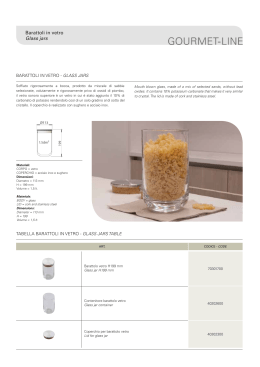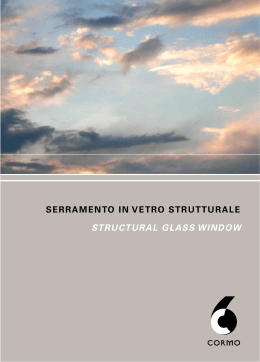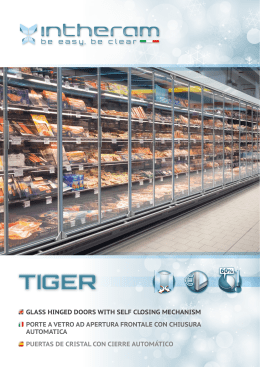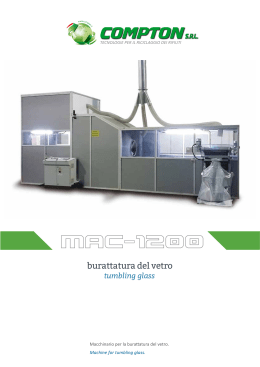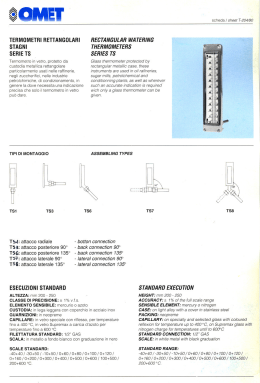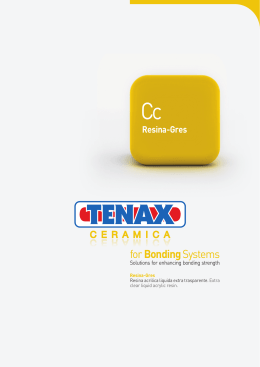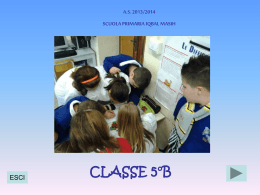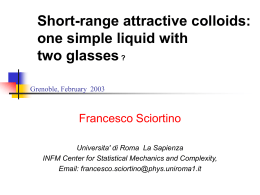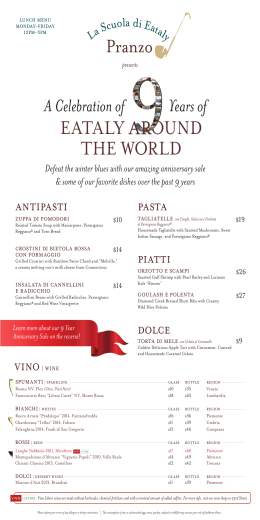Vetro Piano Flat Glasses a quelle del vetro normale. Il vetro temperato è considerato di sicurezza quando in caso di rottura la struttura della frammentazione è in piccole parti, riducendo così notevolmente il rischio di infortunio. Il trattamento consiste nel portare il vetro a circa 650 °C e raffreddarlo velocemente con getti di aria fredda che provocano una compressione nella parte superficiale del vetro e una trazione nella parte interna. Consigli per l’utilizzo del vetro temperato: • Evitare il diretto contatto del vetro con la struttura metallica posizionando un supporto di gomma tra i due. • Gli eventuali fori devono rispettare la distanza minima tra il bordo del vetro ed il bordo del foro di due volte lo spessoredel vetro. • Il diametro del foro non deve essere minore dello spessore del vetro. Thermal tempering Technical features Glass thickness Max. utilisation temperature Temperature difference resistance short term 3 - 19 mm 300 °C 120 K long term 250 °C Reference standards: DIN1249PART12/BS3193/EN60598 Thermal tempering guarantees high mechanical and thermal resistance values that are three times greater than those of normal glass. Tempered glass is considered safety glass, whenever it breaks up into tiny fragments that reduce the risk of injury upon impact. The treatment consists in bringing the glass to a temperature of approx. 650°C and then cooling it quickly by spraying jets of cold air that trigger compression in the surface of the glass and a tractive force inside the glass. Recommendations for the use of tempered glass: • Avoid direct contact between the glass and the metal structure by positioning a rubber support between the two. • Any holes present must respect the following min. distance between the edge of the glass and the edge of the hole: twice the thickness of the glass itself. • The hole diameter must be greater than the thickness of the glass. Tubo Borosilicato Borosilicate Glass Tubes VETRO BOROSILICATO Le ottime proprietà termiche, meccaniche e chimiche fanno si che i campi di applicazione possano essere molteplici: dalle applicazioni tecnico-domestiche (vetri per cucine ed apparecchi da riscaldamento), alle spie di controllo visivo termoresistenti e resistenti agli agenti chimici, all’illuminotecnica in generale oltre che alla meccanica di precisione e all’ottica. Caratteristiche termiche Coefficiente di dilatazione termica lineare Temperatura di trasformazione Tg Massima temperatura di utilizzo* di breve periodo Resistenza alla differenza di temperatura sulla lastra* per brevi periodi fino a 1h. 110 K da 1 a 100 h. 90 K Resistenza allo shock termico** per spessori fino a 4 mm (20/300 °C) 3,25 - 10-6/K 530 °C 500 °C di lungo periodo 450 °C per periodi superiori alle 100 h. 80 K 175 K *resistenza alla differenza di temperatura sulla lastra: lastrine della dimensione di 25 x 25 cm sono riscaldate nella parte centrale mentre il bordo della lastra è mantenuto a temperatura ambiente. La differenza di temperatura che si crea costituisce il valore di riferimento della resistenza al differenziale di temperatura. Durante la prova non si devono verificare rotture superiori al 5%. **resistenza allo shock termico: lastrine della dimensione di 20 x 20 cm vengono riscaldate in maniera uniforme e successivamente viene versata acqua a temperatura ambiente al centro della lastrina. La differenza di temperatura tra la lastra riscaldata e l’acqua versata costituisce il valore di riferimento della resistenza allo shock termico. Durante la prova non si devono verificare rotture superiori al 5%. BOROSILICATE GLASS Excellent thermal, mechanical and chemical properties give this type of glass a wide range of applications: from technicaldomestic applications (glass for kitchens and heating equipment), to chemically-resistant and temperature-resistant visual inspection indicators, illumination technology in general, precision mechanics and optics. Thermal features Coefficient of linear thermal expansion (20/300 °C) 3,25 - 10-6/K Transformation temperature Tg 530 °C Max. utilisation temperature* short term 500 °C long term 450 °C Resistance to temperature difference on the glass plate* for short periods of up to 1 hour 110 K for periods of from 1 to 100 hours 90 K for periods of over 100 hours 80 K Thermal shock resistance** for thickness up to 4 mm: 175 K *Resistance to temperature difference on the glass plate: 25 x 25 cm size glass plates are given heating in their central area and the edge of the plate is kept at room temperature. The difference in temperature created indicates the temperature difference value as to the temperature difference. During the test a max. 5% breakage is acceptable. **resistance to thermal shock: glass plates of 20 x 20 cm size are heated uniformly and then water at room temperature is poured in the center. The difference in temperature between the heated plate and the water poured is the thermal shock resistance reference value. A max. 5% breakage is acceptable. Vetro Piano Flat Glasses Tubo Borosilicato Vetro Piano Borosilicate Glass Tubes Campi di applicazione Le ottime proprietà termiche, meccaniche e chimiche consentono che i campi di applicazione siano molteplici: dall’illuminotecnica per interni ed esterno, all’energia solare, all’industria chimica fino agli articoli decorativi. Application fields Excellent thermal, mechanical and chemical properties give this type of glass a wide range of applications: from indoor/outdoor illumination technology to solar energy to the chemical industry to decorative articles. Caratteristiche fisico/termiche Peso specifico (g/cm3) Coefficiente dilatazione termica lineare (20/300 °C) Temperatura di trasformazione Punto di rammollimento Massima temperatura di utilizzo breve periodo 2,25 3,25 -10-6/K-1 525 °C 820 °C 500 °C lungo periodo 450 °C short therm 2,25 3,25 -10-6/K-1 525 °C 820 °C 500 °C long therm 450 °C Thermal-physical characteristics Specific weight (g/cm3) Coefficient of linear thermal expansion (20/300 °C) Transformation temperature Softening point Max. utilisation temperature Lavorazioni possibili • Taglio: - Tubo intero: lunghezza da 10 mm a 1500 mm - Fresatura: lunghezza max 600 mm - Mezzo tubo: lunghezza max 600 mm • Foratura da ø 4 a 60 mm • Asolatura • Molatura • Sabbiatura completa o parziale • Serigrafia • Verniciatura ad alta e bassa temperatura Caratteristiche ottiche ll vetro Borosilicato è trasparente e chiaro, non mostra assorbimento sostanziale nello spettro visivo. La permeabilità dei raggi ultravioletti rende possibile l’utilizzo di questo vetro per reazioni foto-chimiche. Indice di rifrazione del Borosilicato (l= 589,30 nm) nD 1,472 Costante B foto-elastica 3,6·10-6 MPa-1 La permeabilità della luce del vetro borosiliato è visibile nel seguente grafico. Optical features Borosilicate glass is transparent and clear without significant absorption in the visible spectrum. Permeability by ultraviolet radiation permits this type of glass to be used for photochemical reactions. Borosilicate refraction index (l= 589,30 nm) nD 1,472 Photo-elastic constant 3,6·10-6 MPa-1 The light permeability of borosilicate glass is shown in the following chart. Processing methods • Cutting: - Whole tube: 10 to 1500 mm min. length - Milling: 600 mm max. length - Half tube: 600 mm max. length • Drilling holes from 4 to 60 mm Ø • Slotting • Grinding • Complete or partial sandblasting • Printing • High and low temperature painting Bordi Bordi molati interni ed esterni Internally and externally ground edges Taglio dritto grezzo Straight rough cut Ribruciatura Fire polishing Molle di fissaggio • Fixing springs Flat Glasses Diametro esterno External diameter d1 (mm) 4,0 ± 0,2 5,0 ± 0,2 6,0 ± 0,2 7,0 ± 0,2 8,0 ± 0,2 9,0 ± 0,2 10,0 ± 0,25 11,0 ± 0,25 12,0 ± 0,25 13,0 ± 0,25 14,0 ± 0,25 15,0 ± 0,25 16,0 ± 0,25 17,0 ± 0,25 18,0 ± 0,25 19,0 ± 0,25 20,0 ± 0,25 22,0 ± 0,3 24,0 ± 0,3 26,0 ± 0,3 28,0 ± 0,3 30,0 ± 0,6 32,0 ± 0,6 34,0 ± 0,6 36,0 ± 0,6 38,0 ± 0,6 40,0 ± 0,8 42,0 ± 0,8 44,0 ± 0,8 46,0 ± 0,8 48,0 ± 0,8 50,0 ± 1,0 52,0 ± 1,0 54,0 ± 1,0 56,0 ± 1,0 58,0 ± 1,0 60,0 ± 1,2 65,0 ± 1,2 70,0 ± 1,2 75,0 ± 1,2 80,0 ± 1,2 85,0 ± 1,2 90,0 ± 1,2 95,0 ± 1,2 100,0 ± 1,5 105,0 ± 1,8 110,0 ± 1,5 115,0 ± 1,5 120,0 ± 1,5 125,0 ± 1,5 130,0 ± 1,5 135,0 ± 1,5 140,0 ± 1,5 145,0 ± 1,5 150,0 ± 1,5 VETRO PIANO Spessore Thickness + (mm) 0,8 ± 0,1 0,8 ± 0,1 1,0 ± 0,1 1,0 ± 0,1 1,0 ± 0,1 1,0 ± 0,1 1,0 ± 0,1 1,0 ± 0,1 1,0 ± 0,1 1,0 ± 0,1 1,0 ± 0,1 1,2 ± 0,1 1,2 ± 0,1 1,2 ± 0,1 1,2 ± 0,1 1,2 ± 0,1 1,2 ± 0,1 1,2 ± 0,1 1,2 ± 0,1 1,4 ± 0,1 1,4 ± 0,1 1,4 ± 0,1 1,4 ± 0,1 1,4 ± 0,1 1,4 ± 0,1 1,4 ± 0,1 1,6 ± 0,1 1,6 ± 0,1 1,6 ± 0,1 1,6 ± 0,1 1,6 ± 0,1 1,8 ± 0,15 1,8 ± 0,15 1,8 ± 0,15 1,8 ± 0,15 1,8 ± 0,15 2,2 ± 0,2 2,2 ± 0,2 2,2 ± 0,2 2,2 ± 0,2 2,5 ± 0,2 2,5 ± 0,2 2,5 ± 0,2 2,5 ± 0,2 2,5 ± 0,2 3,0 ± 0,3 3,0 ± 0,3 3,0 ± 0,3 3,0 ± 0,4 3,0 ± 0,4 3,0 ± 0,5 3,0 ± 0,5 3,0 ± 0,5 3,0 ± 0,5 3,0 ± 0,5 1,5 ± 0,1 1,5 ± 0,1 1,5 ± 0,1 1,5 ± 0,1 1,5 ± 0,1 1,5 ± 0,1 1,5 ± 0,1 1,5 ± 0,1 1,5 ± 0,1 1,8 ± 0,1 1,8 ± 0,1 1,8 ± 0,1 1,8 ± 0,1 1,8 ± 0,1 1,8 ± 0,1 1,8 ± 0,1 1,8 ± 0,1 2,0 ± 0,2 2,0 ± 0,2 2,0 ± 0,2 2,0 ± 0,2 2,0 ± 0,2 2,0 ± 0,2 2,0 ± 0,2 2,3 ± 0,2 2,3 ± 0,2 2,3 ± 0,2 2,3 ± 0,2 2,3 ± 0,2 2,5 ± 0,2 2,5 ± 0,2 2,5 ± 0,2 2,5 ± 0,2 2,5 ± 0,2 3,2 ± 0,3 3,2 ± 0,3 3,2 ± 0,3 3,2 ± 0,3 3,5 ± 0,3 3,5 ± 0,3 3,5 ± 0,3 3,5 ± 0,3 3,5 ± 0,3 5,0 ± 0,5 5,0 ± 0,5 5,0 ± 0,5 5,0 ± 0,6 5,0 ± 0,6 5,0 ± 0,6 5,0 ± 0,6 5,0 ± 0,6 5,0 ± 0,6 5,0 ± 0,6 2,2 ± 0,2 2,2 ± 0,2 2,2 ± 0,2 2,2 ± 0,2 2,2 ± 0,2 2,5 ± 0,2 2,5 ± 0,2 2,5 ± 0,2 2,5 ± 0,2 2,5 ± 0,2 2,5 ± 0,2 2,5 ± 0,2 2,5 ± 0,2 2,8 ± 0,2 2,8 ± 0,2 2,8 ± 0,2 2,8 ± 0,2 2,8 ± 0,2 2,8 ± 0,2 2,8 ± 0,2 3,2 ± 0,3 3,2 ± 0,3 3,2 ± 0,3 3,2 ± 0,3 3,2 ± 0,3 3,5 ± 0,3 3,2 ± 0,3 3,2 ± 0,3 3,2 ± 0,3 3,2 ± 0,3 4,2 ± 0,4 4,2 ± 0,4 4,2 ± 0,4 4,2 ± 0,4 5,0 ± 0,5 5,0 ± 0,5 5,0 ± 0,5 5,0 ± 0,5 5,0 ± 0,5 I campi di applicazione possono essere molteplici dall’illuminazione per interni ed esterni al settore decorativo, oltre che ad applicazioni tecnico-domestiche ed industriali. Isaac Glass è in grado di fornire un prodotto personalizzato su disegni tecnici forniti dal cliente. Le lavorazioni possibili possono essere: • taglio • foratura da diametro 4 a 60 mm • asolatura • molatura (vedi foto sotto) • curvatura • tempera fisica e chimica • sabbiatura completa e parziale • acidatura • serigrafia • verniciatura ad alta e bassa temperatura. Per ogni richiesta si può arrivare al prodotto necessario scegliendo il vetro piano che più si avvicina alle vostre esigenze; può essere float normale se non si hanno particolari richieste, oppure temperato termicamente o chimicamente o borosilicato per resistere alle alte temperature. La tecnologia Isaac Glass è in grado di sviluppare forme e dimensioni differenti tenendo conto delle richieste più particolareggiate; • spessore da minimo di 1,2 mm a 19 mm. • lastra dimensione min. 30 x 30 max. 3200 x 2400 mm • dischi dimensione min. 20 mm max 600 mm FLAT GLASS 5,0 ± 0,5 The product's numerous fields of application include indoor/outdoor illumination, articles of decor, and other technical/domestic and industrial applications. Isaac Glass can provide customised products developed as specified by the client's technical drawings. The following processing methods can be applied: • cutting • drilling from 4 to 60 mm silk-screen printing • slot • grinding (see pics above) • bending • physical and chemical tempering • partial and total sandblasting • acid • serigraphy• high and low temperature varnishing For each request we can supply the final product choosing the flat glass which is the closest to your requirements; it can be normal or thermally and chemically tempered, or borosilicate in order to be resistant to the high temperatures. Isaac Glass technology can develop various shapes and dimensions taking in consideration the most detailed requirements. • Thickness from a minimum of 1,2 mm up to 19 mm • Sheets dimension Minimum: 30 x 30 Maximum : 3200 x 2400 • Discs dimensions Minimum: 20 Maximum : 600 Tempera chimica caratteristiche tecniche 5,0 ± 0,4 5,0 ± 0,4 5,0 ± 0,4 5,0 ± 0,4 Spessore vetro Temperatura massima di servizio Resistenza allo shock termico Resistenza alle differenze termiche a breve termine a lungo termine 250 °C Il vetro temperato chimicamente si differenzia dagli altri perché ha superiori caratteristiche meccaniche e termiche. Il trattamento consiste nell’immergere il vetro in una soluzione di nitrato di potassio fuso a 450 °C, provocando uno scambio di ioni tra la soluzione e la superficie del vetro. L’introduzione degli ioni di potassio causa delle forze residue caratterizzate dalla compressione della superfice e compensate dalla trazione interna del vetro. In caso di rottura il vetro non si rompe in piccoli frammenti e non può essere considerato vetro di sicurezza. Chemical tempering technical features Glass thickness Max. utilisation temperature Thermal shock resistance Temperature difference resistance short term 0,5 - 5 mm 300 °C 200 K 180 K long term 250 °C Chemically tempered glass differs from other types due to its superior mechanical and thermal characteristics. Treatment consists in dipping the glass into a molten potassium nitrate solution at a temperature of 450°C that triggers an exchange of ions between the solution and the surface of the glass. The entry of potassium ions causes residual forces characterised by the compression of the surface of the glass that are compensated for by the tractive force generated inside the glass. When the glass breaks, it does not crumble into tiny fragments; so it can not be considered as safety glass. Tempera termica caratteristiche tecniche Spessore vetro Temperatura massima di servizio Resistenza alle differenze termiche • Forme particolari (es. capsule, tubi chiusi ecc.) • Particular shapes (ex. capsule, closed tubes etc.) 0,5 - 5 mm 300 °C 200 K 180 K a breve termine 3 - 19 mm 300 °C 120 K a lungo termine 250 °C Norme di riferimento DIN1249PART12/BS3193/EN60598 Il trattamento di tempera termica garantisce alte resistenze meccaniche e termiche che sono tre volte maggiori se comparate Tubo Borosilicato Vetro Piano Borosilicate Glass Tubes Campi di applicazione Le ottime proprietà termiche, meccaniche e chimiche consentono che i campi di applicazione siano molteplici: dall’illuminotecnica per interni ed esterno, all’energia solare, all’industria chimica fino agli articoli decorativi. Application fields Excellent thermal, mechanical and chemical properties give this type of glass a wide range of applications: from indoor/outdoor illumination technology to solar energy to the chemical industry to decorative articles. Caratteristiche fisico/termiche Peso specifico (g/cm3) Coefficiente dilatazione termica lineare (20/300 °C) Temperatura di trasformazione Punto di rammollimento Massima temperatura di utilizzo breve periodo 2,25 3,25 -10-6/K-1 525 °C 820 °C 500 °C lungo periodo 450 °C short therm 2,25 3,25 -10-6/K-1 525 °C 820 °C 500 °C long therm 450 °C Thermal-physical characteristics Specific weight (g/cm3) Coefficient of linear thermal expansion (20/300 °C) Transformation temperature Softening point Max. utilisation temperature Lavorazioni possibili • Taglio: - Tubo intero: lunghezza da 10 mm a 1500 mm - Fresatura: lunghezza max 600 mm - Mezzo tubo: lunghezza max 600 mm • Foratura da ø 4 a 60 mm • Asolatura • Molatura • Sabbiatura completa o parziale • Serigrafia • Verniciatura ad alta e bassa temperatura Caratteristiche ottiche ll vetro Borosilicato è trasparente e chiaro, non mostra assorbimento sostanziale nello spettro visivo. La permeabilità dei raggi ultravioletti rende possibile l’utilizzo di questo vetro per reazioni foto-chimiche. Indice di rifrazione del Borosilicato (l= 589,30 nm) nD 1,472 Costante B foto-elastica 3,6·10-6 MPa-1 La permeabilità della luce del vetro borosiliato è visibile nel seguente grafico. Optical features Borosilicate glass is transparent and clear without significant absorption in the visible spectrum. Permeability by ultraviolet radiation permits this type of glass to be used for photochemical reactions. Borosilicate refraction index (l= 589,30 nm) nD 1,472 Photo-elastic constant 3,6·10-6 MPa-1 The light permeability of borosilicate glass is shown in the following chart. Processing methods • Cutting: - Whole tube: 10 to 1500 mm min. length - Milling: 600 mm max. length - Half tube: 600 mm max. length • Drilling holes from 4 to 60 mm Ø • Slotting • Grinding • Complete or partial sandblasting • Printing • High and low temperature painting Bordi Bordi molati interni ed esterni Internally and externally ground edges Taglio dritto grezzo Straight rough cut Ribruciatura Fire polishing Molle di fissaggio • Fixing springs Flat Glasses Diametro esterno External diameter d1 (mm) 4,0 ± 0,2 5,0 ± 0,2 6,0 ± 0,2 7,0 ± 0,2 8,0 ± 0,2 9,0 ± 0,2 10,0 ± 0,25 11,0 ± 0,25 12,0 ± 0,25 13,0 ± 0,25 14,0 ± 0,25 15,0 ± 0,25 16,0 ± 0,25 17,0 ± 0,25 18,0 ± 0,25 19,0 ± 0,25 20,0 ± 0,25 22,0 ± 0,3 24,0 ± 0,3 26,0 ± 0,3 28,0 ± 0,3 30,0 ± 0,6 32,0 ± 0,6 34,0 ± 0,6 36,0 ± 0,6 38,0 ± 0,6 40,0 ± 0,8 42,0 ± 0,8 44,0 ± 0,8 46,0 ± 0,8 48,0 ± 0,8 50,0 ± 1,0 52,0 ± 1,0 54,0 ± 1,0 56,0 ± 1,0 58,0 ± 1,0 60,0 ± 1,2 65,0 ± 1,2 70,0 ± 1,2 75,0 ± 1,2 80,0 ± 1,2 85,0 ± 1,2 90,0 ± 1,2 95,0 ± 1,2 100,0 ± 1,5 105,0 ± 1,8 110,0 ± 1,5 115,0 ± 1,5 120,0 ± 1,5 125,0 ± 1,5 130,0 ± 1,5 135,0 ± 1,5 140,0 ± 1,5 145,0 ± 1,5 150,0 ± 1,5 VETRO PIANO Spessore Thickness + (mm) 0,8 ± 0,1 0,8 ± 0,1 1,0 ± 0,1 1,0 ± 0,1 1,0 ± 0,1 1,0 ± 0,1 1,0 ± 0,1 1,0 ± 0,1 1,0 ± 0,1 1,0 ± 0,1 1,0 ± 0,1 1,2 ± 0,1 1,2 ± 0,1 1,2 ± 0,1 1,2 ± 0,1 1,2 ± 0,1 1,2 ± 0,1 1,2 ± 0,1 1,2 ± 0,1 1,4 ± 0,1 1,4 ± 0,1 1,4 ± 0,1 1,4 ± 0,1 1,4 ± 0,1 1,4 ± 0,1 1,4 ± 0,1 1,6 ± 0,1 1,6 ± 0,1 1,6 ± 0,1 1,6 ± 0,1 1,6 ± 0,1 1,8 ± 0,15 1,8 ± 0,15 1,8 ± 0,15 1,8 ± 0,15 1,8 ± 0,15 2,2 ± 0,2 2,2 ± 0,2 2,2 ± 0,2 2,2 ± 0,2 2,5 ± 0,2 2,5 ± 0,2 2,5 ± 0,2 2,5 ± 0,2 2,5 ± 0,2 3,0 ± 0,3 3,0 ± 0,3 3,0 ± 0,3 3,0 ± 0,4 3,0 ± 0,4 3,0 ± 0,5 3,0 ± 0,5 3,0 ± 0,5 3,0 ± 0,5 3,0 ± 0,5 1,5 ± 0,1 1,5 ± 0,1 1,5 ± 0,1 1,5 ± 0,1 1,5 ± 0,1 1,5 ± 0,1 1,5 ± 0,1 1,5 ± 0,1 1,5 ± 0,1 1,8 ± 0,1 1,8 ± 0,1 1,8 ± 0,1 1,8 ± 0,1 1,8 ± 0,1 1,8 ± 0,1 1,8 ± 0,1 1,8 ± 0,1 2,0 ± 0,2 2,0 ± 0,2 2,0 ± 0,2 2,0 ± 0,2 2,0 ± 0,2 2,0 ± 0,2 2,0 ± 0,2 2,3 ± 0,2 2,3 ± 0,2 2,3 ± 0,2 2,3 ± 0,2 2,3 ± 0,2 2,5 ± 0,2 2,5 ± 0,2 2,5 ± 0,2 2,5 ± 0,2 2,5 ± 0,2 3,2 ± 0,3 3,2 ± 0,3 3,2 ± 0,3 3,2 ± 0,3 3,5 ± 0,3 3,5 ± 0,3 3,5 ± 0,3 3,5 ± 0,3 3,5 ± 0,3 5,0 ± 0,5 5,0 ± 0,5 5,0 ± 0,5 5,0 ± 0,6 5,0 ± 0,6 5,0 ± 0,6 5,0 ± 0,6 5,0 ± 0,6 5,0 ± 0,6 5,0 ± 0,6 2,2 ± 0,2 2,2 ± 0,2 2,2 ± 0,2 2,2 ± 0,2 2,2 ± 0,2 2,5 ± 0,2 2,5 ± 0,2 2,5 ± 0,2 2,5 ± 0,2 2,5 ± 0,2 2,5 ± 0,2 2,5 ± 0,2 2,5 ± 0,2 2,8 ± 0,2 2,8 ± 0,2 2,8 ± 0,2 2,8 ± 0,2 2,8 ± 0,2 2,8 ± 0,2 2,8 ± 0,2 3,2 ± 0,3 3,2 ± 0,3 3,2 ± 0,3 3,2 ± 0,3 3,2 ± 0,3 3,5 ± 0,3 3,2 ± 0,3 3,2 ± 0,3 3,2 ± 0,3 3,2 ± 0,3 4,2 ± 0,4 4,2 ± 0,4 4,2 ± 0,4 4,2 ± 0,4 5,0 ± 0,5 5,0 ± 0,5 5,0 ± 0,5 5,0 ± 0,5 5,0 ± 0,5 I campi di applicazione possono essere molteplici dall’illuminazione per interni ed esterni al settore decorativo, oltre che ad applicazioni tecnico-domestiche ed industriali. Isaac Glass è in grado di fornire un prodotto personalizzato su disegni tecnici forniti dal cliente. Le lavorazioni possibili possono essere: • taglio • foratura da diametro 4 a 60 mm • asolatura • molatura (vedi foto sotto) • curvatura • tempera fisica e chimica • sabbiatura completa e parziale • acidatura • serigrafia • verniciatura ad alta e bassa temperatura. Per ogni richiesta si può arrivare al prodotto necessario scegliendo il vetro piano che più si avvicina alle vostre esigenze; può essere float normale se non si hanno particolari richieste, oppure temperato termicamente o chimicamente o borosilicato per resistere alle alte temperature. La tecnologia Isaac Glass è in grado di sviluppare forme e dimensioni differenti tenendo conto delle richieste più particolareggiate; • spessore da minimo di 1,2 mm a 19 mm. • lastra dimensione min. 30 x 30 max. 3200 x 2400 mm • dischi dimensione min. 20 mm max 600 mm FLAT GLASS 5,0 ± 0,5 The product's numerous fields of application include indoor/outdoor illumination, articles of decor, and other technical/domestic and industrial applications. Isaac Glass can provide customised products developed as specified by the client's technical drawings. The following processing methods can be applied: • cutting • drilling from 4 to 60 mm silk-screen printing • slot • grinding (see pics above) • bending • physical and chemical tempering • partial and total sandblasting • acid • serigraphy• high and low temperature varnishing For each request we can supply the final product choosing the flat glass which is the closest to your requirements; it can be normal or thermally and chemically tempered, or borosilicate in order to be resistant to the high temperatures. Isaac Glass technology can develop various shapes and dimensions taking in consideration the most detailed requirements. • Thickness from a minimum of 1,2 mm up to 19 mm • Sheets dimension Minimum: 30 x 30 Maximum : 3200 x 2400 • Discs dimensions Minimum: 20 Maximum : 600 Tempera chimica caratteristiche tecniche 5,0 ± 0,4 5,0 ± 0,4 5,0 ± 0,4 5,0 ± 0,4 Spessore vetro Temperatura massima di servizio Resistenza allo shock termico Resistenza alle differenze termiche a breve termine a lungo termine 250 °C Il vetro temperato chimicamente si differenzia dagli altri perché ha superiori caratteristiche meccaniche e termiche. Il trattamento consiste nell’immergere il vetro in una soluzione di nitrato di potassio fuso a 450 °C, provocando uno scambio di ioni tra la soluzione e la superficie del vetro. L’introduzione degli ioni di potassio causa delle forze residue caratterizzate dalla compressione della superfice e compensate dalla trazione interna del vetro. In caso di rottura il vetro non si rompe in piccoli frammenti e non può essere considerato vetro di sicurezza. Chemical tempering technical features Glass thickness Max. utilisation temperature Thermal shock resistance Temperature difference resistance short term 0,5 - 5 mm 300 °C 200 K 180 K long term 250 °C Chemically tempered glass differs from other types due to its superior mechanical and thermal characteristics. Treatment consists in dipping the glass into a molten potassium nitrate solution at a temperature of 450°C that triggers an exchange of ions between the solution and the surface of the glass. The entry of potassium ions causes residual forces characterised by the compression of the surface of the glass that are compensated for by the tractive force generated inside the glass. When the glass breaks, it does not crumble into tiny fragments; so it can not be considered as safety glass. Tempera termica caratteristiche tecniche Spessore vetro Temperatura massima di servizio Resistenza alle differenze termiche • Forme particolari (es. capsule, tubi chiusi ecc.) • Particular shapes (ex. capsule, closed tubes etc.) 0,5 - 5 mm 300 °C 200 K 180 K a breve termine 3 - 19 mm 300 °C 120 K a lungo termine 250 °C Norme di riferimento DIN1249PART12/BS3193/EN60598 Il trattamento di tempera termica garantisce alte resistenze meccaniche e termiche che sono tre volte maggiori se comparate Tubo Borosilicato Vetro Piano Borosilicate Glass Tubes Campi di applicazione Le ottime proprietà termiche, meccaniche e chimiche consentono che i campi di applicazione siano molteplici: dall’illuminotecnica per interni ed esterno, all’energia solare, all’industria chimica fino agli articoli decorativi. Application fields Excellent thermal, mechanical and chemical properties give this type of glass a wide range of applications: from indoor/outdoor illumination technology to solar energy to the chemical industry to decorative articles. Caratteristiche fisico/termiche Peso specifico (g/cm3) Coefficiente dilatazione termica lineare (20/300 °C) Temperatura di trasformazione Punto di rammollimento Massima temperatura di utilizzo breve periodo 2,25 3,25 -10-6/K-1 525 °C 820 °C 500 °C lungo periodo 450 °C short therm 2,25 3,25 -10-6/K-1 525 °C 820 °C 500 °C long therm 450 °C Thermal-physical characteristics Specific weight (g/cm3) Coefficient of linear thermal expansion (20/300 °C) Transformation temperature Softening point Max. utilisation temperature Lavorazioni possibili • Taglio: - Tubo intero: lunghezza da 10 mm a 1500 mm - Fresatura: lunghezza max 600 mm - Mezzo tubo: lunghezza max 600 mm • Foratura da ø 4 a 60 mm • Asolatura • Molatura • Sabbiatura completa o parziale • Serigrafia • Verniciatura ad alta e bassa temperatura Caratteristiche ottiche ll vetro Borosilicato è trasparente e chiaro, non mostra assorbimento sostanziale nello spettro visivo. La permeabilità dei raggi ultravioletti rende possibile l’utilizzo di questo vetro per reazioni foto-chimiche. Indice di rifrazione del Borosilicato (l= 589,30 nm) nD 1,472 Costante B foto-elastica 3,6·10-6 MPa-1 La permeabilità della luce del vetro borosiliato è visibile nel seguente grafico. Optical features Borosilicate glass is transparent and clear without significant absorption in the visible spectrum. Permeability by ultraviolet radiation permits this type of glass to be used for photochemical reactions. Borosilicate refraction index (l= 589,30 nm) nD 1,472 Photo-elastic constant 3,6·10-6 MPa-1 The light permeability of borosilicate glass is shown in the following chart. Processing methods • Cutting: - Whole tube: 10 to 1500 mm min. length - Milling: 600 mm max. length - Half tube: 600 mm max. length • Drilling holes from 4 to 60 mm Ø • Slotting • Grinding • Complete or partial sandblasting • Printing • High and low temperature painting Bordi Bordi molati interni ed esterni Internally and externally ground edges Taglio dritto grezzo Straight rough cut Ribruciatura Fire polishing Molle di fissaggio • Fixing springs Flat Glasses Diametro esterno External diameter d1 (mm) 4,0 ± 0,2 5,0 ± 0,2 6,0 ± 0,2 7,0 ± 0,2 8,0 ± 0,2 9,0 ± 0,2 10,0 ± 0,25 11,0 ± 0,25 12,0 ± 0,25 13,0 ± 0,25 14,0 ± 0,25 15,0 ± 0,25 16,0 ± 0,25 17,0 ± 0,25 18,0 ± 0,25 19,0 ± 0,25 20,0 ± 0,25 22,0 ± 0,3 24,0 ± 0,3 26,0 ± 0,3 28,0 ± 0,3 30,0 ± 0,6 32,0 ± 0,6 34,0 ± 0,6 36,0 ± 0,6 38,0 ± 0,6 40,0 ± 0,8 42,0 ± 0,8 44,0 ± 0,8 46,0 ± 0,8 48,0 ± 0,8 50,0 ± 1,0 52,0 ± 1,0 54,0 ± 1,0 56,0 ± 1,0 58,0 ± 1,0 60,0 ± 1,2 65,0 ± 1,2 70,0 ± 1,2 75,0 ± 1,2 80,0 ± 1,2 85,0 ± 1,2 90,0 ± 1,2 95,0 ± 1,2 100,0 ± 1,5 105,0 ± 1,8 110,0 ± 1,5 115,0 ± 1,5 120,0 ± 1,5 125,0 ± 1,5 130,0 ± 1,5 135,0 ± 1,5 140,0 ± 1,5 145,0 ± 1,5 150,0 ± 1,5 VETRO PIANO Spessore Thickness + (mm) 0,8 ± 0,1 0,8 ± 0,1 1,0 ± 0,1 1,0 ± 0,1 1,0 ± 0,1 1,0 ± 0,1 1,0 ± 0,1 1,0 ± 0,1 1,0 ± 0,1 1,0 ± 0,1 1,0 ± 0,1 1,2 ± 0,1 1,2 ± 0,1 1,2 ± 0,1 1,2 ± 0,1 1,2 ± 0,1 1,2 ± 0,1 1,2 ± 0,1 1,2 ± 0,1 1,4 ± 0,1 1,4 ± 0,1 1,4 ± 0,1 1,4 ± 0,1 1,4 ± 0,1 1,4 ± 0,1 1,4 ± 0,1 1,6 ± 0,1 1,6 ± 0,1 1,6 ± 0,1 1,6 ± 0,1 1,6 ± 0,1 1,8 ± 0,15 1,8 ± 0,15 1,8 ± 0,15 1,8 ± 0,15 1,8 ± 0,15 2,2 ± 0,2 2,2 ± 0,2 2,2 ± 0,2 2,2 ± 0,2 2,5 ± 0,2 2,5 ± 0,2 2,5 ± 0,2 2,5 ± 0,2 2,5 ± 0,2 3,0 ± 0,3 3,0 ± 0,3 3,0 ± 0,3 3,0 ± 0,4 3,0 ± 0,4 3,0 ± 0,5 3,0 ± 0,5 3,0 ± 0,5 3,0 ± 0,5 3,0 ± 0,5 1,5 ± 0,1 1,5 ± 0,1 1,5 ± 0,1 1,5 ± 0,1 1,5 ± 0,1 1,5 ± 0,1 1,5 ± 0,1 1,5 ± 0,1 1,5 ± 0,1 1,8 ± 0,1 1,8 ± 0,1 1,8 ± 0,1 1,8 ± 0,1 1,8 ± 0,1 1,8 ± 0,1 1,8 ± 0,1 1,8 ± 0,1 2,0 ± 0,2 2,0 ± 0,2 2,0 ± 0,2 2,0 ± 0,2 2,0 ± 0,2 2,0 ± 0,2 2,0 ± 0,2 2,3 ± 0,2 2,3 ± 0,2 2,3 ± 0,2 2,3 ± 0,2 2,3 ± 0,2 2,5 ± 0,2 2,5 ± 0,2 2,5 ± 0,2 2,5 ± 0,2 2,5 ± 0,2 3,2 ± 0,3 3,2 ± 0,3 3,2 ± 0,3 3,2 ± 0,3 3,5 ± 0,3 3,5 ± 0,3 3,5 ± 0,3 3,5 ± 0,3 3,5 ± 0,3 5,0 ± 0,5 5,0 ± 0,5 5,0 ± 0,5 5,0 ± 0,6 5,0 ± 0,6 5,0 ± 0,6 5,0 ± 0,6 5,0 ± 0,6 5,0 ± 0,6 5,0 ± 0,6 2,2 ± 0,2 2,2 ± 0,2 2,2 ± 0,2 2,2 ± 0,2 2,2 ± 0,2 2,5 ± 0,2 2,5 ± 0,2 2,5 ± 0,2 2,5 ± 0,2 2,5 ± 0,2 2,5 ± 0,2 2,5 ± 0,2 2,5 ± 0,2 2,8 ± 0,2 2,8 ± 0,2 2,8 ± 0,2 2,8 ± 0,2 2,8 ± 0,2 2,8 ± 0,2 2,8 ± 0,2 3,2 ± 0,3 3,2 ± 0,3 3,2 ± 0,3 3,2 ± 0,3 3,2 ± 0,3 3,5 ± 0,3 3,2 ± 0,3 3,2 ± 0,3 3,2 ± 0,3 3,2 ± 0,3 4,2 ± 0,4 4,2 ± 0,4 4,2 ± 0,4 4,2 ± 0,4 5,0 ± 0,5 5,0 ± 0,5 5,0 ± 0,5 5,0 ± 0,5 5,0 ± 0,5 I campi di applicazione possono essere molteplici dall’illuminazione per interni ed esterni al settore decorativo, oltre che ad applicazioni tecnico-domestiche ed industriali. Isaac Glass è in grado di fornire un prodotto personalizzato su disegni tecnici forniti dal cliente. Le lavorazioni possibili possono essere: • taglio • foratura da diametro 4 a 60 mm • asolatura • molatura (vedi foto sotto) • curvatura • tempera fisica e chimica • sabbiatura completa e parziale • acidatura • serigrafia • verniciatura ad alta e bassa temperatura. Per ogni richiesta si può arrivare al prodotto necessario scegliendo il vetro piano che più si avvicina alle vostre esigenze; può essere float normale se non si hanno particolari richieste, oppure temperato termicamente o chimicamente o borosilicato per resistere alle alte temperature. La tecnologia Isaac Glass è in grado di sviluppare forme e dimensioni differenti tenendo conto delle richieste più particolareggiate; • spessore da minimo di 1,2 mm a 19 mm. • lastra dimensione min. 30 x 30 max. 3200 x 2400 mm • dischi dimensione min. 20 mm max 600 mm FLAT GLASS 5,0 ± 0,5 The product's numerous fields of application include indoor/outdoor illumination, articles of decor, and other technical/domestic and industrial applications. Isaac Glass can provide customised products developed as specified by the client's technical drawings. The following processing methods can be applied: • cutting • drilling from 4 to 60 mm silk-screen printing • slot • grinding (see pics above) • bending • physical and chemical tempering • partial and total sandblasting • acid • serigraphy• high and low temperature varnishing For each request we can supply the final product choosing the flat glass which is the closest to your requirements; it can be normal or thermally and chemically tempered, or borosilicate in order to be resistant to the high temperatures. Isaac Glass technology can develop various shapes and dimensions taking in consideration the most detailed requirements. • Thickness from a minimum of 1,2 mm up to 19 mm • Sheets dimension Minimum: 30 x 30 Maximum : 3200 x 2400 • Discs dimensions Minimum: 20 Maximum : 600 Tempera chimica caratteristiche tecniche 5,0 ± 0,4 5,0 ± 0,4 5,0 ± 0,4 5,0 ± 0,4 Spessore vetro Temperatura massima di servizio Resistenza allo shock termico Resistenza alle differenze termiche a breve termine a lungo termine 250 °C Il vetro temperato chimicamente si differenzia dagli altri perché ha superiori caratteristiche meccaniche e termiche. Il trattamento consiste nell’immergere il vetro in una soluzione di nitrato di potassio fuso a 450 °C, provocando uno scambio di ioni tra la soluzione e la superficie del vetro. L’introduzione degli ioni di potassio causa delle forze residue caratterizzate dalla compressione della superfice e compensate dalla trazione interna del vetro. In caso di rottura il vetro non si rompe in piccoli frammenti e non può essere considerato vetro di sicurezza. Chemical tempering technical features Glass thickness Max. utilisation temperature Thermal shock resistance Temperature difference resistance short term 0,5 - 5 mm 300 °C 200 K 180 K long term 250 °C Chemically tempered glass differs from other types due to its superior mechanical and thermal characteristics. Treatment consists in dipping the glass into a molten potassium nitrate solution at a temperature of 450°C that triggers an exchange of ions between the solution and the surface of the glass. The entry of potassium ions causes residual forces characterised by the compression of the surface of the glass that are compensated for by the tractive force generated inside the glass. When the glass breaks, it does not crumble into tiny fragments; so it can not be considered as safety glass. Tempera termica caratteristiche tecniche Spessore vetro Temperatura massima di servizio Resistenza alle differenze termiche • Forme particolari (es. capsule, tubi chiusi ecc.) • Particular shapes (ex. capsule, closed tubes etc.) 0,5 - 5 mm 300 °C 200 K 180 K a breve termine 3 - 19 mm 300 °C 120 K a lungo termine 250 °C Norme di riferimento DIN1249PART12/BS3193/EN60598 Il trattamento di tempera termica garantisce alte resistenze meccaniche e termiche che sono tre volte maggiori se comparate Vetro Piano Flat Glasses a quelle del vetro normale. Il vetro temperato è considerato di sicurezza quando in caso di rottura la struttura della frammentazione è in piccole parti, riducendo così notevolmente il rischio di infortunio. Il trattamento consiste nel portare il vetro a circa 650 °C e raffreddarlo velocemente con getti di aria fredda che provocano una compressione nella parte superficiale del vetro e una trazione nella parte interna. Consigli per l’utilizzo del vetro temperato: • Evitare il diretto contatto del vetro con la struttura metallica posizionando un supporto di gomma tra i due. • Gli eventuali fori devono rispettare la distanza minima tra il bordo del vetro ed il bordo del foro di due volte lo spessoredel vetro. • Il diametro del foro non deve essere minore dello spessore del vetro. Thermal tempering Technical features Glass thickness Max. utilisation temperature Temperature difference resistance short term 3 - 19 mm 300 °C 120 K long term 250 °C Reference standards: DIN1249PART12/BS3193/EN60598 Thermal tempering guarantees high mechanical and thermal resistance values that are three times greater than those of normal glass. Tempered glass is considered safety glass, whenever it breaks up into tiny fragments that reduce the risk of injury upon impact. The treatment consists in bringing the glass to a temperature of approx. 650°C and then cooling it quickly by spraying jets of cold air that trigger compression in the surface of the glass and a tractive force inside the glass. Recommendations for the use of tempered glass: • Avoid direct contact between the glass and the metal structure by positioning a rubber support between the two. • Any holes present must respect the following min. distance between the edge of the glass and the edge of the hole: twice the thickness of the glass itself. • The hole diameter must be greater than the thickness of the glass. Tubo Borosilicato Borosilicate Glass Tubes VETRO BOROSILICATO Le ottime proprietà termiche, meccaniche e chimiche fanno si che i campi di applicazione possano essere molteplici: dalle applicazioni tecnico-domestiche (vetri per cucine ed apparecchi da riscaldamento), alle spie di controllo visivo termoresistenti e resistenti agli agenti chimici, all’illuminotecnica in generale oltre che alla meccanica di precisione e all’ottica. Caratteristiche termiche Coefficiente di dilatazione termica lineare Temperatura di trasformazione Tg Massima temperatura di utilizzo* di breve periodo Resistenza alla differenza di temperatura sulla lastra* per brevi periodi fino a 1h. 110 K da 1 a 100 h. 90 K Resistenza allo shock termico** per spessori fino a 4 mm (20/300 °C) 3,25 - 10-6/K 530 °C 500 °C di lungo periodo 450 °C per periodi superiori alle 100 h. 80 K 175 K *resistenza alla differenza di temperatura sulla lastra: lastrine della dimensione di 25 x 25 cm sono riscaldate nella parte centrale mentre il bordo della lastra è mantenuto a temperatura ambiente. La differenza di temperatura che si crea costituisce il valore di riferimento della resistenza al differenziale di temperatura. Durante la prova non si devono verificare rotture superiori al 5%. **resistenza allo shock termico: lastrine della dimensione di 20 x 20 cm vengono riscaldate in maniera uniforme e successivamente viene versata acqua a temperatura ambiente al centro della lastrina. La differenza di temperatura tra la lastra riscaldata e l’acqua versata costituisce il valore di riferimento della resistenza allo shock termico. Durante la prova non si devono verificare rotture superiori al 5%. BOROSILICATE GLASS Excellent thermal, mechanical and chemical properties give this type of glass a wide range of applications: from technicaldomestic applications (glass for kitchens and heating equipment), to chemically-resistant and temperature-resistant visual inspection indicators, illumination technology in general, precision mechanics and optics. Thermal features Coefficient of linear thermal expansion (20/300 °C) 3,25 - 10-6/K Transformation temperature Tg 530 °C Max. utilisation temperature* short term 500 °C long term 450 °C Resistance to temperature difference on the glass plate* for short periods of up to 1 hour 110 K for periods of from 1 to 100 hours 90 K for periods of over 100 hours 80 K Thermal shock resistance** for thickness up to 4 mm: 175 K *Resistance to temperature difference on the glass plate: 25 x 25 cm size glass plates are given heating in their central area and the edge of the plate is kept at room temperature. The difference in temperature created indicates the temperature difference value as to the temperature difference. During the test a max. 5% breakage is acceptable. **resistance to thermal shock: glass plates of 20 x 20 cm size are heated uniformly and then water at room temperature is poured in the center. The difference in temperature between the heated plate and the water poured is the thermal shock resistance reference value. A max. 5% breakage is acceptable. Vetro Piano Flat Glasses Vetro Piano Flat Glasses a quelle del vetro normale. Il vetro temperato è considerato di sicurezza quando in caso di rottura la struttura della frammentazione è in piccole parti, riducendo così notevolmente il rischio di infortunio. Il trattamento consiste nel portare il vetro a circa 650 °C e raffreddarlo velocemente con getti di aria fredda che provocano una compressione nella parte superficiale del vetro e una trazione nella parte interna. Consigli per l’utilizzo del vetro temperato: • Evitare il diretto contatto del vetro con la struttura metallica posizionando un supporto di gomma tra i due. • Gli eventuali fori devono rispettare la distanza minima tra il bordo del vetro ed il bordo del foro di due volte lo spessoredel vetro. • Il diametro del foro non deve essere minore dello spessore del vetro. Thermal tempering Technical features Glass thickness Max. utilisation temperature Temperature difference resistance short term 3 - 19 mm 300 °C 120 K long term 250 °C Reference standards: DIN1249PART12/BS3193/EN60598 Thermal tempering guarantees high mechanical and thermal resistance values that are three times greater than those of normal glass. Tempered glass is considered safety glass, whenever it breaks up into tiny fragments that reduce the risk of injury upon impact. The treatment consists in bringing the glass to a temperature of approx. 650°C and then cooling it quickly by spraying jets of cold air that trigger compression in the surface of the glass and a tractive force inside the glass. Recommendations for the use of tempered glass: • Avoid direct contact between the glass and the metal structure by positioning a rubber support between the two. • Any holes present must respect the following min. distance between the edge of the glass and the edge of the hole: twice the thickness of the glass itself. • The hole diameter must be greater than the thickness of the glass. Tubo Borosilicato Borosilicate Glass Tubes VETRO BOROSILICATO Le ottime proprietà termiche, meccaniche e chimiche fanno si che i campi di applicazione possano essere molteplici: dalle applicazioni tecnico-domestiche (vetri per cucine ed apparecchi da riscaldamento), alle spie di controllo visivo termoresistenti e resistenti agli agenti chimici, all’illuminotecnica in generale oltre che alla meccanica di precisione e all’ottica. Caratteristiche termiche Coefficiente di dilatazione termica lineare Temperatura di trasformazione Tg Massima temperatura di utilizzo* di breve periodo Resistenza alla differenza di temperatura sulla lastra* per brevi periodi fino a 1h. 110 K da 1 a 100 h. 90 K Resistenza allo shock termico** per spessori fino a 4 mm (20/300 °C) 3,25 - 10-6/K 530 °C 500 °C di lungo periodo 450 °C per periodi superiori alle 100 h. 80 K 175 K *resistenza alla differenza di temperatura sulla lastra: lastrine della dimensione di 25 x 25 cm sono riscaldate nella parte centrale mentre il bordo della lastra è mantenuto a temperatura ambiente. La differenza di temperatura che si crea costituisce il valore di riferimento della resistenza al differenziale di temperatura. Durante la prova non si devono verificare rotture superiori al 5%. **resistenza allo shock termico: lastrine della dimensione di 20 x 20 cm vengono riscaldate in maniera uniforme e successivamente viene versata acqua a temperatura ambiente al centro della lastrina. La differenza di temperatura tra la lastra riscaldata e l’acqua versata costituisce il valore di riferimento della resistenza allo shock termico. Durante la prova non si devono verificare rotture superiori al 5%. BOROSILICATE GLASS Excellent thermal, mechanical and chemical properties give this type of glass a wide range of applications: from technicaldomestic applications (glass for kitchens and heating equipment), to chemically-resistant and temperature-resistant visual inspection indicators, illumination technology in general, precision mechanics and optics. Thermal features Coefficient of linear thermal expansion (20/300 °C) 3,25 - 10-6/K Transformation temperature Tg 530 °C Max. utilisation temperature* short term 500 °C long term 450 °C Resistance to temperature difference on the glass plate* for short periods of up to 1 hour 110 K for periods of from 1 to 100 hours 90 K for periods of over 100 hours 80 K Thermal shock resistance** for thickness up to 4 mm: 175 K *Resistance to temperature difference on the glass plate: 25 x 25 cm size glass plates are given heating in their central area and the edge of the plate is kept at room temperature. The difference in temperature created indicates the temperature difference value as to the temperature difference. During the test a max. 5% breakage is acceptable. **resistance to thermal shock: glass plates of 20 x 20 cm size are heated uniformly and then water at room temperature is poured in the center. The difference in temperature between the heated plate and the water poured is the thermal shock resistance reference value. A max. 5% breakage is acceptable. Vetro Piano Flat Glasses
Scarica

